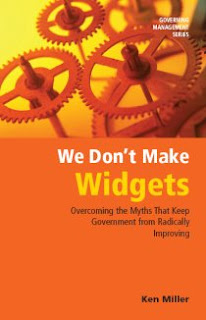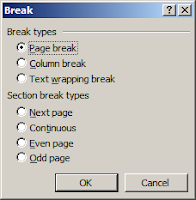 The essence of the book is in this paragraph from page six:
The essence of the book is in this paragraph from page six:The three myths--we don't make widgets, we don't have customers, and we're not here to make a profit--prevent us from seeing the reality of our organizations. Simply put: organizations, both public and private, are collections of systems. Systems are processes (including the inputs, suppliers, and employees who work in the processes) that produce widgets for customers in order to achieve some desired result or outcome. The way we improve an organization is to improve its systems.
(My comment: it would be interesting to contrast this thesis with that from the book Systemantics--maybe another time).
On page 13 Mr. Miller phrases this another way which I believe is telling of the rest of the book's approach:
You can't improve government by looking at it from 30,000 feet. The problems with government aren't visible at that level. It's only when you open up the roof and see the factories inside that you can find the opportunities. Improving government is a battle that is won on the ground, not through the air.
On page 30 Mr. Miller quotes Robin Lawton from the book Creating a Customer-Centered Culture: Leadership in Quality, Innovation, and Speed when he describes a widget as:
something created by work, which can be given to someone else to achieve a desired outcome.
On page 35 Mr. Miller further summarizes what he sees as our only options on how to improve:
If you want better results (outcomes), your options are actually very few: change what you produce (the widget), or change how you produce it (the process).
Memorable Quotes:
The best way to get meaningful measures is not to ask for measures, but to ask for answers--answers to questions that everyone wants to know.
-Page 43
Aggressive measuring changes the learning and behavior of a human being to the same extent that meteorology can change the weather.
- Peter Block, "Someone to Watch Over Me," News for a Change, March 2001
Vision is not enough, it much be combined with venture. It is not enough to stare up the steps, we must step up the stairs."
-Va'clav Havel, Communist reformer in the Czech Republic


















